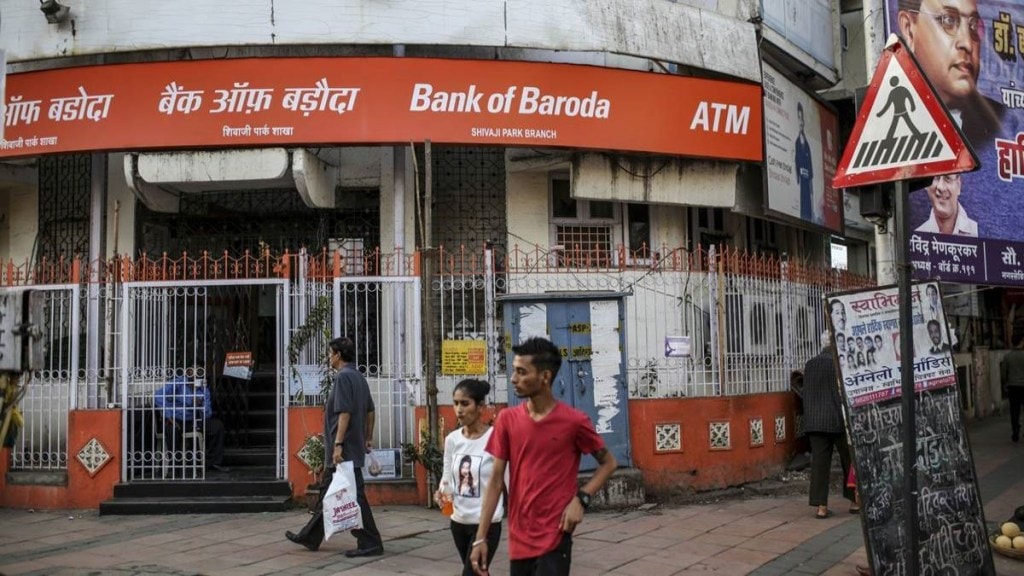The net profit of Bank of Baroda rose 28.4% year-on-year in July-September due to growth in its advances.
The state-owned bank posted a bottomline of Rs 4,253 crore in the quarter under review, up 4.5% on a sequential basis. The net profit topped the Rs 3,921 crore estimated by Bloomberg.
The bank’s domestic gross advances rose nearly 17% year-on-year to Rs 8.3 trillion as on September 30, aided by a growth in retail loans.
Retail loans rose 22% year-on-year to Rs 1.9 trillion as on September 30.
Specifically, personal loans rose 67.2%, and gold loans rose 65.2%. Agriculture loans rose nearly 14% on an annual basis.
Corporate loans rose nearly 17% to Rs 3.5 trillion as on September 30.
Going ahead, the bank’s loan book is expected to grow at over 15%. The corporate loan book is expected to grow at 12-13%, and the retail book is expected to grow at over 20%.
The bank intends to increase its retail loan mix to 35% in two to three years from nearly 28% currently. The corporate loan mix will drop to 35% from 42.1%.
Net interest income, the difference between interest earned and expended, rose nearly 7% to Rs 10,831 crore in the quarter under review, aided by a growth in advances.
Domestic deposits rose 12% year-on-year to Rs 10.7 trillion as on September 30. Term deposits rose nearly 18% to Rs 6.5 trillion.
The share of low-cost current account savings account (CASA) deposits fell to 40% as on September 30 from 43% a year ago. The bank intends to improve CASA ratio of 41% in the near future.
As a result of the rise in the share of pricey term deposits, the bank’s net interest margin fell to 3.07% in the September quarter from 3.33% a year ago. Going ahead, the bank intends to maintain a margin of 3.15%.
Asset quality
The bank’s gross non-performing asset ratio fell to 3.3% as on September 30 from 5.31% a year ago. The net non-performing asset ratio fell 40 basis points (bps) to 0.76%.
Fresh slippages were Rs 4,331 crore in the quarter under review. Cash recoveries and upgrades were Rs 2,207 crore.
Non-performing assets were highest in the micro, small and medium-sized enterprises (MSME) segment at Rs 11,037 crore. Bad loans in the agriculture segment were at Rs 6,982 crore.
The bank made recoveries were Rs 3,438 crore in July-September. The slippage ratio rose to 1.81% as on September 30 from 1.77% a year ago.
“Our slippage ratio looks elevated but this includes one large aviation account (Go First) worth Rs 1,773 crore. If you exclude this account, the slippage ratio would have been 1.08%,” chief financial officer Ian De Souza said, adding that this particular account has been fully provided for on an exposure of Rs 1,200 crore. The bank has also made additional provisions to strengthen the balance sheet.
Total provisions rose nearly 33% year-on-year to Rs 2,161 crore in the quarter under review. The provision coverage ratio stood at 93.16% as on September 30. Return on assets improved 13 bps to 1.14% as on September 30.
The capital adequacy ratio rose 5 bps to 15.30% as on September 30.
On October 10, the Reserve Bank of India (RBI) directed the bank to suspend any further onboarding of customers onto its ‘bob World’ mobile application, based on certain supervisory concerns.
Further onboarding of customers on the BOB World application will be subject to further strengthening of related processes by the Bank to the satisfaction of RBI.
“We have taken action on a large set of people on the field. As far as the chief digital officer is concerned, it is a cessation of service induced by the bank. That is termination. Currently, we have put in somebody as a CDO,” managing director and chief executive officer Debadatta Chand said, adding that the bank will appoint a new chief digital officer if the need arises.
While the bank has corrected its customer onboarding processes in line with RBI’s course of action, Chand could not specify any timeline as to when bob World would resume onboarding of customers.

